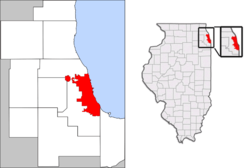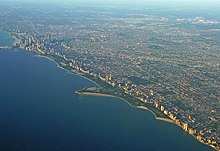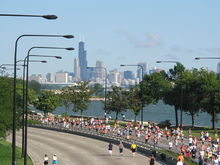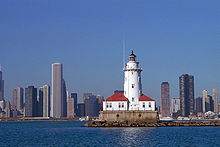During the mid-18th century, the area was inhabited by a native American tribe known as the Potawatomi, who had taken the place of the Miami and Sauk and Fox peoples. The 1780s saw the arrival of the first known non-indigenous permanent settler in Chicago, Jean Baptiste Point du Sable, who is believed to be of African and European descent. In 1795, following the Northwest Indian War, an area that was to be part of Chicago was turned over by some Native Americans in the Treaty of Greenville to the United States for a military post.
In 1803, the United States Army built Fort Dearborn, which was destroyed in the War of 1812 Battle of Fort Dearborn. The Ottawa, Ojibwe, and Potawatomi had ceded additional land to the United States in the 1804 Treaty of St. Louis. The Potawatomi were eventually forcibly removed from their land following theTreaty of Chicago in 1833. On August 12, 1833, the Town of Chicago was organized with a population of around 200 at that time. Within seven years it would grow to a population of over 4,000. The City of Chicago was incorporated on Saturday, March 4, 1837—the same day that Martin van Buren was inaugurated as President (succeeding Andrew Jackson).
The name "Chicago" is derived from a French rendering of the Native American word shikaakwa, translated as "wild onion" or "wild garlic," from the Miami-Illinois language. The first known reference to the site of the current city of Chicago as "Checagou" was by Robert de LaSalle around 1679 in a memoir written about the time. The wild garlic plants, Allium tricoccum, were described by LaSalle's comrade, naturalist-diarist Henri Joutel, in his journal of LaSalle's last expedition.
State and Madison Streets, the busiest corner in Chicago (1897) As the site of the Chicago Portage, the city emerged as an important transportation hub between the eastern and western United States. Chicago's first railway, Galena and Chicago Union Railroad, opened in 1848, which also marked the opening of the Illinois and Michigan Canal. The canal allowed steamboats and sailing ships on the Great Lakes to connect to the Mississippi River. A flourishing economy brought residents from rural communities and immigrants abroad. Manufacturing and retail sectors became dominant among Midwestern cities, influencing the American economy, particularly in meatpacking, with the advent of the refrigerated rail car and the regional centrality of the city's Union Stock Yards.
Chicago experienced some of the fastest population growth in the world, requiring infrastructure investments. In February 1856, the Chesbrough plan for the building of Chicago's and the United States' first comprehensive sewerage system was approved by the Common Council. The project raised much of central Chicago to a new grade. While raising Chicago out of its mud and sewage, and at first improving the health of the city, the untreated sewage and industrial waste now flowed into theChicago River, thence into Lake Michigan, polluting the primary source of fresh water for the city. Chicago responded by tunneling two miles (3 km) out into Lake Michigan to newly built water cribs. In 1900, the problem of sewage was largely resolved when the city undertook a major engineering feat. The city reversed the flow of the Chicago River so that water flowed from Lake Michigan into the river, instead of the water flowing from the river into the lake. It began with the construction and improvement of the Illinois and Michigan Canal, and completed with the Chicago Sanitary and Ship Canal leading to the Illinois River which joins the Mississippi River.

Artist's rendering of the Great Chicago Fire of 1871 After the Great Chicago Fire of 1871 destroyed a third of the city, including the entire central business district, Chicago experienced rapid rebuilding and growth. During its rebuilding period, Chicago constructed the world's first skyscraper in 1885, using steel-skeleton construction. Labor conflicts and unrest followed, including theHaymarket affair on May 4, 1886. Concern for social problems among Chicago's lower classes led Jane Addams to be a co-founder of Hull House in 1889. Programs developed there became a model for the new field of social work. The city also invested in many large, well-landscaped municipal parks, which also included public sanitation facilities.
In the 19th century, Chicago became an important railroad center and in 1883 the standardized system of North American Time Zones was adopted by the general time convention of railway managers in Chicago. This gave the continent its uniform system for telling time.
In 1893, Chicago hosted the World's Columbian Exposition on former marshland at the present location of Jackson Park. The Exposition drew 27.5 million visitors, and is considered the most influential world's fair in history. The University of Chicago was founded in 1892 on the same South Side location. The term "midway" for a fair or carnival referred originally to the Midway Plaisance, a strip of park land that still runs through the University of Chicago campus and connects Washington and Jackson Parks.
20th and 21st centuries

The Chicago River is the south border (right) of the Near North Side and Streeterville and the north border (left) of Chicago Loop, Lakeshore East andIllinois Center (from Lake Shore Drive's Link Bridgewith Trump International Hotel and Tower at jog in the river in the center) The 1920s brought notoriety to Chicago as gangsters, including the notorious Al Capone, battled each other and law enforcement on the city streets during theProhibition era. Chicago had over 1,000 gangs in the 1920s.
The 1920s also saw a major expansion in industry. The availability of jobs attracted African Americans from the South. Between 1910 and 1930, the black population of Chicago increased from 44,103 to 233,903. Arriving in the hundreds of thousands during the Great Migration, the newcomers had an immense cultural impact. It was during this wave that Chicago became a center for jazz, with King Oliver leading the way.
In 1933, Chicago Mayor Anton Cermak was fatally wounded in Miami during a failed assassination attempt on President-elect Franklin D. Roosevelt. In 1933 and 1934, the city celebrated its centennial by hosting the Century of Progress International Exposition Worlds Fair. The theme of the fair was technological innovation over the century since Chicago's founding.
On December 2, 1942, physicist Enrico Fermi conducted the world's first controlled nuclear reaction at the University of Chicago as part of the top-secret Manhattan Project.
Mayor Richard J. Daley was elected in 1955, in the era of machine politics. Starting in the early 1960s due to blockbusting, many white residents, as in most American cities, left the city for the suburbs. Whole neighboorhoods were completely changed based on race. Structural changes in industry caused heavy losses of jobs for lower skilled workers. In 1966 James Bevel, Martin Luther King, Jr., and Albert Raby led the Chicago Open Housing Movement, which culminated in agreements between Mayor Richard J. Daley and the movement leaders. Two years later, the city hosted the tumultuous 1968 Democratic National Convention, which featured physical confrontations both inside and outside the convention hall, including full-scale riots, or in some cases police riots, in city streets. Major construction projects, including the Sears Tower (now known as the Willis Tower, which in 1974 became the world's tallest building), University of Illinois at Chicago, McCormick Place, and O'Hare International Airport, were undertaken during Richard J. Daley's tenure. When Richard J. Daley died, Michael Anthony Bilandic served as mayor for three years. Bilandic's subsequent loss in a primary election has been attributed to the city's inability to properly plow city streets during a heavy snowstorm. In 1979, Jane Byrne, the city's first female mayor, was elected. She popularized the city as a movie location and tourist destination.
In 1983, Harold Washington became the first African American to be elected to the office of mayor, in one of the closest mayoral elections in Chicago. After Washington won the Democratic primary, racial motivations caused a few Democratic alderman and ward committeemen to back the Republican candidate Bernard Epton, who ran on the race-baiting slogan Before it's too late. Washington's term in office saw new attention given to poor and minority neighborhoods. Washington died in office of a heart attack in 1987, shortly after being elected to a second term. Richard M. Daley, son of Richard J. Daley, was elected in 1989. His accomplishments included improvements to parks and creating incentives for sustainable development. After successfully standing for reelection five times and becoming Chicago's longest serving Mayor, in 2010, Richard M. Daley announced he would step down at the end of his final term in May 2011.
On February 23, 2011, former White House chief of staff and congressman Rahm Emanuel won the municipal election to succeed Daley, beating five rivals with 55 percent of the vote. Emanuel was sworn in as Mayor on May 16, 2011.















